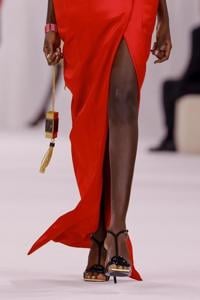PARIS (AP) — Olivier Rousteing opened Balmain’s Wednesday show at Paris Fashion Week with an audacious angular micro-gown — a glittering number featuring peaked shoulders, humped hips and a massive clasping hand motif. It was clear from the start: this season’s Balmain was not going to be a study in subtlety.
Meanwhile, Nicolas Di Felice’s latest offering for Courrèges took the audience into a futuristic world.
Here are some highlights of Wednesday's shows:
Balmain’s eyes, shoulders and a dash of chaos
, ever the showman, leaned into extremes, delivering a collection that unapologetically fused boldness with a dose of camp.
Prints of half-painted women’s faces guided the eye down floor-length gowns, while disembodied eyes, lips, noses and nails formed the visual leitmotifs of the evening. At its core, this collection’s identity hinged on the sculptural, almost scaffolded, shoulders — a signature of Balmain’s power dressing reimagined yet again. The peaking effect extended to the hips in gold-striped chain mini-dresses, evoking an exaggerated 1980s glamour.
Not every look hit the mark, however. A pink-beige conical suit suffered from wonky asymmetry, with a bustline that seemed comically repelled by the garment itself, a reminder of Rousteing’s tendency to overindulge in his maximalist ambitions. As with past collections, the lack of restraint occasionally detracted from the overall coherence, a critique that has followed him across seasons.
That said, there were moments of pure fun and theatricality, such as a cream skirt with a 3D face peering out, a delightful nod to Rousteing’s penchant for surrealist humor. This playful audacity keeps the Balmain faithful coming back, even when some pieces falter under the weight of their own excess. Rousteing’s balancing act between bold experimentation and structural precision remains his triumph and Achilles’ heel.
In many ways, this collection echoed themes in his archive: an obsession with exaggerated silhouettes, a love for sculptural shoulders, and a desire to embed his personal narrative into the fabric of his designs. But as always with Balmain, the risk and spectacle are as much a part of the show as the clothes themselves. This time, Rousteing leaned heavily into both. Whether all his risks paid off is up for debate, but one thing is certain: subtlety was never on the agenda.
Courrèges' space-age minimalism lands with off-kilter kick
Di Felice took the audience into a space-age world, with models circling a black abyss inside the Carreau du Temple in Paris’ Marais. The minimalism that has become his signature was on full display, but the subtle and unexpected touches provided a signature off-kilter, fashion-forward kick. In a collection starting with black and charcoal hues, trapeze silhouette dresses featured slits instead of sleeves, allowing models to reveal their arms in a cool, confident gesture. The looks exuded a slick, rebellious sensuality, paired with black turtlenecks and knee-high, skin-tight boots. Ubiquitous wrap-around shades made the models seem untouchable, too cool for school.
Yet, this wasn’t just a simplistic exercise in minimalism. Di Felice’s knack for combining sensuality with technical prowess elevated the collection. The geometric halter necks and precise cuts in the dresses —often with lopped-off shoulders — gave the silhouettes a surgical quality, while unexpected lengths in the backs of skirts and thick, loosely flapping hems kept the collection fresh.
The spirit of , the ’60s visionary who defined the Space Age, was alive. Di Felice’s nod to that era came in nipped, slim-shouldered gowns in white and slightly flared pants — echoes of Courrèges’ legacy reimagined. Exposed midriffs, another ’60s reference, were revisited with a modern, daring twist: a simple strap across the bust like a fashion hyphen, elegant in its minimalism.
Di Felice’s style lies in his ability to evoke a sense of intimacy without jumping on the “naked dressing” trend, which has been the talk of the fashion world. Instead, he stays true to his slyly-coded version of Parisian chic, subtly provocative without being over the top.
Dries Van Noten’s 1st show without Dries
Dries Van Noten's first collection since the eponymous designer dared to walk the tightrope between innovation and heritage. The runway was a testament to Van Noten’s influence, weaving together historical references with futuristic silhouettes in a display that felt both familiar and fresh.
The show opened with a loose silhouetted snake-print coat, its deconstructed 1920s vibe setting the tone for the collection. This was no mere nostalgia trip, though. A trench coat, accentuated by bold black hems, recalled the graphic sensibilities of a video game or an animated classic like “Tintin.” It was playful yet refined, reflecting Van Noten's over his 40-year reign.
One of the standout pieces was an 18th-century-inspired Bordeaux soldier’s coat, ruffled sleeves and all, grounding the collection in historical sensibility. This sense of history and textural contrasts in sensual blues, reds and salmons embodied Van Noten’s legacy. Pastel tones played against flashes of gold, high-waisted skirts embraced femininity, and upturned shirt necks added a touch of whimsy.
For all its elegance, the collection echoed familiar critiques of Van Noten’s recent works: a tension between spectacle and subtlety, where the drama of their presentation can occasionally overshadow the clothes themselves. Yet, as the pieces paraded down the runway, each garment — whether steeped in nostalgia or pushing the boundaries of modern design — proved Van Noten’s guiding philosophy: style over fashion.
Rabanne delivers incongruity and joy
Julien Dossena’s latest offering was a paradox. Model Gigi Hadid kicked off the show in a blue pastel-striped shirt ensemble with a striking diagonal cut and unexpected skorts, setting the tone for a collection defined by its unpredictable mix of ideas. Oversized, big-shouldered jackets soon took over the runway, injecting a sense of power dressing, while flashes of the house’s signature chain mail dresses reminded the audience of Rabanne’s unmistakable DNA.
However, amid the brilliance, there were missteps. A gold gown with an awkward silhouette, too clunky to flatter, and a striped blue dress featuring an ill-conceived bow served as the low points of the evening. These pieces strayed into impracticality — an echo of critiques often leveled at Dossena’s work, where creativity sometimes sacrifices functionality. The unflattering elements highlighted how his avant-garde designs occasionally tread the impractical line, even as they push boundaries.
Yet, Dossena’s signature craftsmanship and talent for weaving in unexpected joy were undeniable. An oversized boxy tuxedo, with shimmering mermaid-like lapels, stood out, offering a moment of pure sartorial delight. It was a masterclass in Dossena’s ability to innovate, blending surrealism with wearable fashion—something he’s been praised for, even in his most experimental moments. As always with Dossena, the unexpected was expected.









































